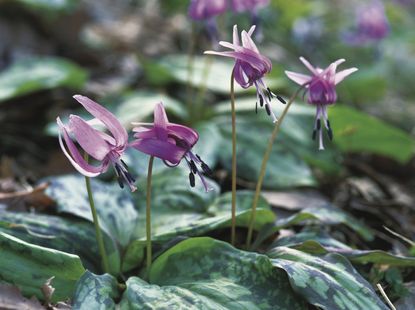Growing Dogtooth Violets: Learn About Dogtooth Violet Trout Lily


Dogtooth violet trout lily (Erythronium albidum) is a perennial wildflower that grows in woodlands and mountain meadows. It is commonly found across much of the eastern United States. The nectar-rich little blooms are highly attractive to a variety of native bees. Removing wildflowers from their natural setting isn't beneficial to the environment and usually isn't successful. If you're thinking about growing dogtooth violets in your garden, look for the bulbs or plants at nurseries that specialize in native plants. Once the plant is established in your garden, it is easily propagated by digging and replanting the offsets in late summer.
What Does a Dogtooth Violet Look Like?
Dogtooth violet isn't a violet and the drooping, lily-like blooms are actually white with a subtle, violet tint. The flowers, which bloom in early spring, open in morning and close in evening. Each flower is accompanied by two bright green leaves marked with reddish brown, trout-like spots. The plant is named for the small underground bulb, which resembles a dog's pointed canine tooth. Mature height of a dogtooth violet plant is 6 to 12 inches (15-31 cm.).
Planting Dogtooth Violet Bulbs
There isn't much effort needed when growing dogtooth violets in the woodland garden. Dogtooth trout lily performs well in a location in dappled sunlight or light shade, such as a spot under a deciduous tree. Although dogwood trout lily prefers moist soil, it benefits from drier soil during its dormant period in summer and fall. To plant dogtooth violet bulbs, loosen the soil with a garden fork or spade, then plant the small bulbs, pointy end up, about 5 inches (13 cm.) apart, with approximately 2 inches (5 cm.) between each bulb. Water well to settle the soil around the bulbs. The bulbs will develop roots in the fall.
Care of Dogtooth Trout Lily
Water dogtooth trout lily as needed throughout the growing season, then decrease water after blooming. Usually, one deep watering per week is plenty. Don't be tempted to remove foliage after dogtooth trout lily stops blooming. In order to produce flowers the following year, the bulbs require food created when energy is absorbed by the leaves. Wait until the leaves die down and turn yellow. A loose mulch, such as dried, chopped leaves, will protect the bulbs during the winter.
Gardening tips, videos, info and more delivered right to your inbox!
Sign up for the Gardening Know How newsletter today and receive a free download of our most popular eBook "How to Grow Delicious Tomatoes."

A Credentialed Garden Writer, Mary H. Dyer was with Gardening Know How in the very beginning, publishing articles as early as 2007.
-
 How To Get Rid Of Mosquitoes In The Garden: 9 Natural Ways To Make Them Buzz Off!
How To Get Rid Of Mosquitoes In The Garden: 9 Natural Ways To Make Them Buzz Off!How to get rid of mosquitoes is on the minds of people in the summer in almost every region of the world. Learn how to repel the pests without toxic chemicals.
By Mary Ellen Ellis
-
 Monkey Orchid Care: How To Grow This Fascinating Species
Monkey Orchid Care: How To Grow This Fascinating SpeciesThe monkey orchid bears a remarkable resemblance to its namesake and, with a little know-how, can be successfully grown as a houseplant.
By Bonnie L. Grant